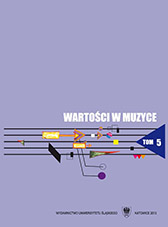Podstawowe zagadnienia sacrum w muzyce
Basic aspects of the sacred in music
Author(s): Roman Ireneusz DrozdSubject(s): Music
Published by: Wydawnictwo Uniwersytetu Śląskiego
Keywords: the sacred in music; the sacred-profane dichotomy; universalist personalism; art vs religion
Summary/Abstract: The very text is intended by the author to be a fundamental philosophical, religiological and theological determinant of the area at the meeting of the sacred and music. In order to have a joint position, the very determinant (also serving as a starting point for a further discourse) is connected with the key notions of a “person” and “beauty” from the perspective of universalist personalism. For these reasons, the article touches upon three issues: a synthetic analysis of the notion of the sacred; the sacred in a correlation between art and religion, and the sacred as a personal criterion in music. Basic contents: 1. The sacred is the subject of interest of art and many scientific sciences, mainly religiology, philosophy and theology. For theology it is the holy of holiness, real and personal. 2. The profane is antithetic towards the sacred only in an ontological, not axiological sense. The profane is not an anti-sacred reality, but an autonomous one in power to become sacrified. 3. In monotheistic religions, the relationships between man and the sacred are personal in nature, but on the basis of not as much the law (Islam, Judaism), as, above all, according to the agapethic rule (Christianity). 4. The sacred has a personal, Calonistic and praxelogical dimension (man is also determined to create, discover and contemplate beauty). 5. Works having sacred inspirations are positive in nature, to give an example. The very act can be considered homophony (antropophany). 6. Many thinkers treat averbal music as sacred where one can objectively find a sacred idiom. In this context, there is no obligation for an artist to be a believer strictly speaking. The text is addressed to all creative circles, mainly composers, conductors, and music critics, but also the circles of the clergymen.
Journal: Wartości w muzyce
- Issue Year: 2013
- Issue No: 5
- Page Range: 34-60
- Page Count: 27
- Language: Polish

